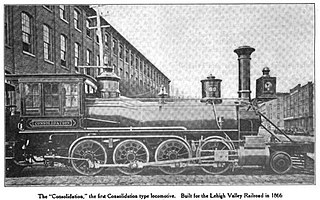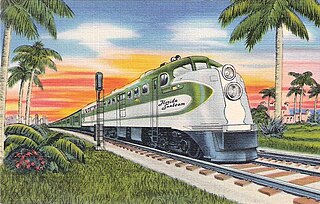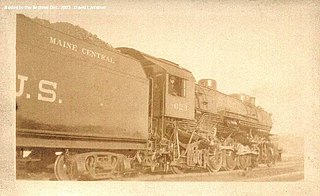Related Research Articles

The American Locomotive Company was an American manufacturer of locomotives, diesel generators, steel, and tanks that operated from 1901 to 1969. The company was formed by the merger of seven smaller locomotive manufacturers and Schenectady Locomotive Engine Manufactory of Schenectady, New York. A subsidiary, American Locomotive Automobile Company, designed and manufactured automobiles under the Alco brand from 1905 to 1913. ALCO also produced nuclear reactors from 1954 to 1962.

Under the Whyte notation for the classification of steam locomotives, 2-8-0 represents the wheel arrangement of two leading wheels on one axle, usually in a leading truck, eight powered and coupled driving wheels on four axles, and no trailing wheels. In the United States and elsewhere, this wheel arrangement is commonly known as a Consolidation, after the Lehigh and Mahanoy Railroad’s Consolidation, the name of the first 2-8-0.

The ALCO RS-1 was a 4-axle diesel-electric locomotive built by Alco-GE between 1941 and 1953 and the American Locomotive Company from 1953 to 1960. ALCO subsidiary Montreal Locomotive Works built an additional three RS-1s in 1954. This model has the distinction of having the longest production run of any diesel locomotive for the North American market. The RS-1 was in production for 19 years from the first unit Rock Island #748 in March 1941 to the last unit National of Mexico #5663 in March 1960.

The ALCO RS-2 is a 1,500–1,600 horsepower (1,100–1,200 kW) B-B diesel-electric locomotive built by the American Locomotive Company (ALCO) from 1946 to 1950. ALCO introduced the model after World War II as an improvement on the ALCO RS-1. Between 1946 and 1950, 377 examples of the RS-2 were built, primarily for American and Canadian customers.

The ALCO DL-109 was one of six models of A1A-A1A diesel locomotives built to haul passenger trains by the American Locomotive Company (ALCO) between December, 1939 and April, 1945. They were of a cab unit design, and both cab-equipped lead A units DL-103b, DL-105, DL-107, DL-109 and cabless booster B units DL-108, DL-110 models were built. The units were styled by noted industrial designer Otto Kuhler, who incorporated into his characteristic cab the trademark three-piece windshield design. A total of 74 cab units and four cabless booster units were built.

The ALCO FA was a family of B-B diesel locomotives designed to haul freight trains. The locomotives were built by a partnership of ALCO and General Electric in Schenectady, New York, between January 1946 and May 1959. Designed by General Electric's Ray Patten, they were of a cab unit design; both cab-equipped lead FA and cabless booster FB models were built. A dual passenger-freight version, the FPA/FPB, was also offered. It was equipped with a steam generator for heating passenger cars.
The ALCO DL-202-2 and DL-203-2 diesel-electric locomotive was an experimental freight locomotive produced by ALCO of Schenectady, New York. The primary diesel builders Alco, Baldwin and EMD pushed the War Production Board (WPB) for more opportunities to build more diesels. The Transportation Equipment Division of the WPB announced a production schedule on December 10, 1943, that allowed Alco to build one 4500 horsepower experimental diesel locomotive. This experimental diesel locomotive was to be built in the fourth quarter of 1944. The two A units were built in January 1945 and the B unit at a later date in 1945. The two A units were put on test at Building No. 37 at Schenectady to work out problems with the connecting rods and turbocharger in the Alco 241 engine, developed by both McIntosh and Seymour and ALCo. The total production run included 2 cab DL202-2 A units, and a single DL203-2 B unit. The locomotives were powered by a V12 ALCO 241 diesel engine, rated at 1,500 hp (1.1 MW). The units were released for test in September 1945. The locomotive could attain a top speed of 80 mph (130 km/h) (Freight) and 125 mph (201 km/h) (Passenger). With the B-B wheel arrangement and carbody construction, equipment layout and electrical gear these experimental units were the immediate predecessors of the FA units to come in early 1946. Outwardly, the bodies strongly resembled those on the DL-109, some of which were still under construction at Schenectady in early 1945.
The ALCO DL560C is a series of diesel-electric locomotive with AC electric transmission designed by the American Locomotive Company and produced under license by Banaras Locomotive Works (BLW) Varanasi, India for Indian Railways as their classes WDM-2, WDM-3A/2C, WDM-3D and WDG-3A for operation in India. The locomotive is fitted with a 16-cylinder ALCO 251 B,C diesel engine. In the early 1960s Indian Railways needed a reliable diesel workhorse to gradually replace its steam locomotive fleet. Equal numbers of ALCO's DL560C and EMD's G16 were chosen for trials. More locomotives of each of these were purchased for more trials. Indian Railways was keen on producing these locomotives in the country rather than depending on imports. EMD did not agree for a Transfer-of-Technology, while ALCO did. Thus ALCO DL560C was chosen for the job due to its easy maintenance, reliability and simple operation. And from then on vast numbers of this loco in different configurations have been produced and remain the main diesel traction power of Indian Railways.

The Mountain Division is a railroad line that was once owned and operated by the Maine Central Railroad (MEC). It stretches from Portland, Maine on the Atlantic Ocean, through the Western Maine Mountains and White Mountains of New Hampshire, ending at St. Johnsbury, Vermont in the Northeast Kingdom. The line was abandoned in 1983 by MEC's successor, Guilford Transportation Industries (GTI). Guilford retained a stub between Portland and Westbrook. A section in New Hampshire remains in use by heritage railway Conway Scenic Railroad.
The Calais Branch is a mothballed railroad line in Maine that was operated by the Maine Central Railroad Company (MEC).

R-Motor was the class designation given by the New York Central one prototype and a later fleet of 42 ALCO-GE built electric freight locomotives for use in the New York Electrified Zone. In conjunction with the P Motors, the Rs marked the second generation of electric locomotives built for the New York Central. Also like the P Motors they used advanced nose suspended traction motors and the R-2s were some of the first North American locomotives to make use of the C-C wheel arrangement, which later became the standard for diesel electric road freight.

Maine Central Railroad Class S locomotives were intended for heavy freight service. They were of 2-8-2 wheel arrangement in the Whyte notation, or " 1'D1' " in UIC classification. They replaced earlier class W 2-8-0 locomotives beginning in 1914. They were the largest and most modern steam freight locomotives built for Maine Central; although former Boston and Maine Railroad 2-10-2s were later purchased to handle World War II freight traffic. Class S locomotives pulled freight trains over the main line between Portland and Bangor, Maine; and are best remembered for service on the Mountain Division from 1929, when the class X Mallet locomotives were scrapped, until replacement by diesel locomotives in the early 1950s.
Maine Central Railroad Class O locomotives were originally intended for heavy freight service. They were of 4-6-0 wheel arrangement in the Whyte notation, or "2'C" in UIC classification. They replaced earlier class P 2-6-0 locomotives beginning in 1903. They were in turn replaced by class W 2-8-0 locomotives for the heaviest freight service beginning in 1910, but remained in use on branch line trains until replaced by diesel locomotives after World War II. They proved so well-suited for branch line service the design was among the last steam locomotives built for the Maine Central.
Maine Central Railroad Class H locomotives were intended for branch line passenger service. They were of 4-4-0 wheel arrangement in the Whyte notation, or "2'B" in UIC classification. Built by the American Locomotive Company's (ALCO) Manchester in 1898 the last were completed at ALCO's Schenectady, New York plant in 1898 all were scrapped between 1916 and 1921. None of the Maine Central Class H 4-4-0 were preserved.
Maine Central Railroad Class C locomotives were intended for main line passenger service. They were of 4-6-2 wheel arrangement in the Whyte notation, or " 2'C1' " in UIC classification. They replaced earlier class N 4-6-0 locomotives beginning in 1907. Class C locomotives pulled named passenger trains until replacement by diesel locomotives after World War II.
Maine Central Railroad steam switchers were designated Class K. They were of 0-6-0 wheel arrangement in the Whyte notation, or "C" in UIC classification. American Locomotive Company (ALCO) began building more powerful yard locomotives for Maine Central in 1909. Twenty locomotives numbered 161 through 180 were active in 1923, and worked in Maine's largest cities until replaced by diesels after World War II.
Maine Central Railroad Class M locomotives were originally intended for heavy freight service. They were of 2-6-0 wheel arrangement in the Whyte notation, or "1'C" in UIC classification. They were replaced by class P 2-6-0 locomotives for the heaviest freight service beginning in 1896, and spent their final years as yard switchers. The oldest of the class surviving past United States Railroad Administration operation were Portland Company builders numbers 606 and 607 built in 1890. Eleven built by Schenectady Locomotive Works in 1893 and 1894 also appeared in the 221-245 number sequence on Maine Central's 1923 locomotive roster. The longest surviving representatives of the class were three built by Schenectady in 1897 as Portland and Rumford Falls Railway numbers 10 through 12. These three were rebuilt with higher-pressure boilers in Maine Central's Waterville shop between 1914 and 1921 as sub-class M-5. These reboilered locomotives with 25,000 lbf (111.2 kN) tractive effort were numbered 246 through 248. Number 247 was the last survivor of the class when scrapped in 1946.
Maine Central Railroad Class P locomotives were originally intended for heavy freight service. They were of 2-6-0 wheel arrangement in the Whyte notation, or "1'C" in UIC classification. They replaced class M 2-6-0s for the heaviest freight service beginning in 1896. They were transferred to branch line service as replaced by class O 4-6-0 locomotives beginning in 1903. Most were scrapped during the Great Depression and none survived World War II.
Maine Central Railroad began operating diesel locomotives in 1935, and had retired all steam locomotives by 1954. That time interval was a joint operating period with the Boston and Maine Railroad (B&M). This article describes diesel locomotives owned by Maine Central through the period of joint operation and later independent operation prior to Guilford Rail System control in 1981.
References
- 1 2 3 Robertson, Edwin B. (1977). Maine Central Steam Locomotives. Westbrook, Maine: Edwin B. Robertson. pp. 44–47.
- ↑ "Pictures of MEC 519" (PDF). National Park Service. Retrieved 2013-03-03.
- ↑ http://briansolomon.com/trackingthelight/2022/09/13/maine-central-501-on-the-move/
- ↑ Plant, Jeremy F. & Melvin, George F. (1999). Maine Central in Color Volume 2. Morning Sun Books. p. 70. ISBN 1-58248-030-3.
- ↑ Robertson, Edwin B. (1978). Maine Central Diesel Locomotives. Edwin B. Robertson. pp. 35, 41 & 49.